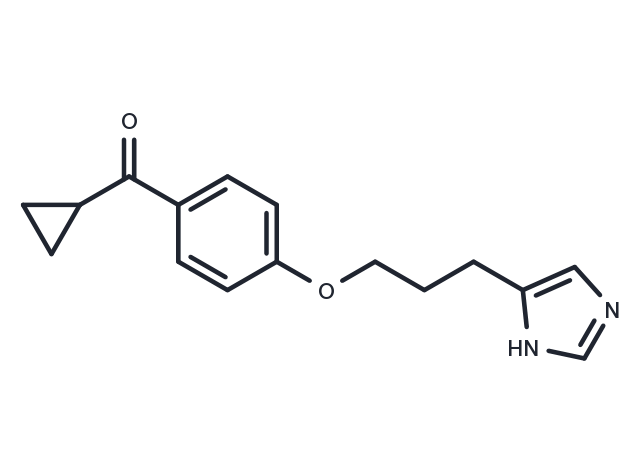Powder: -20°C for 3 years | In solvent: -80°C for 1 year


Ciproxifan (FUB-359) is a highly effective and specific histamin H3-receptor antagonist (IC50: 9.2 nM).

| Pack Size | Availability | Price/USD | Quantity |
|---|---|---|---|
| 1 mg | In stock | $ 37.00 | |
| 2 mg | In stock | $ 50.00 | |
| 5 mg | In stock | $ 74.00 | |
| 10 mg | In stock | $ 113.00 | |
| 25 mg | In stock | $ 236.00 | |
| 50 mg | 4-6 weeks | $ 423.00 |


| Description | Ciproxifan (FUB-359) is a highly effective and specific histamin H3-receptor antagonist (IC50: 9.2 nM). |
| Targets&IC50 | H3 receptor:9.2 nM |
| In vitro | Ciproxifan inhibits [3H]HA release from synaptosomes with Ki of 0.5 nM. Ciproxifan inhibits the binding of [125I]iodoproxyfan at the brain H3 receptor with Ki of 0.7 nM. Ciproxifan displays high affinity at H3 receptor but shows low apparent affinity at other receptor subtypes as evaluated in functional tests on isolated organs (histamine H1 and H2, muscarinic M3, adrenergic α1D and β1, serotonin 5-HT1B, 5-HT2A, 5-HT3 and 5-HT4). [1] |
| Kinase Assay | PPMTase Assays : Synaptosomal membranes of rat brain cerebellum or total membranes of cultured cell lines (100,000 × g pellet) are used for methyltransferase assays in the cell-free systems. Methyltransferase assays are performed at 37°C in 50 mM Tris-HCl buffer, pH 7.4, using 100 μg of protein, 25 μM [methyl-3H]AdoMet (300,000 cpm/nmol), and 50 μM AFC (prepared as a stock solution in DMSO) in a total volume of 50 μL. DMSO concentration in all assays is 8%. Various AFC concentrations are used in several experiments as indicated in the text. Reactions are terminated after 10 min by addition of 500 μL of chloroform:methanol (1:1) with subsequent addition of 250 μL of Water, mixing, and phase separation. A 125-μL portion of the chloroform phase is dried at 40°C, and 200 μl of 1 N NaOH, 1% SDS solution is added. The methanol thus formed is counted by the vapor phase equilibrium method. Typical background counts (no AFC added) are 50-100 cpm, while typical reactions with AFC yield 500-6,000 cpm. Assays are performed in triplicate, and background counts are subtracted. Methylation of endogenous substrates and gel electrophoresis are performed. Protein carboxyl methylation in intact cells is determined using 100 μCi/mL [methyl-3H]methionine. Cells are assayed in near confluent cultures grown in 10-cm plates with 5 mL of labeling medium. |
| Synonyms | FUB-359 |
| Molecular Weight | 270.33 |
| Formula | C16H18N2O2 |
| CAS No. | 184025-18-1 |
Powder: -20°C for 3 years | In solvent: -80°C for 1 year
Ethanol: 54 mg/mL (139.75 mM)
DMSO: 10 mM
You can also refer to dose conversion for different animals. More
bottom
Please see Inhibitor Handling Instructions for more frequently ask questions. Topics include: how to prepare stock solutions, how to store products, and cautions on cell-based assays & animal experiments, etc.
Ciproxifan 184025-18-1 GPCR/G Protein Immunology/Inflammation Neuroscience Histamine Receptor inhibit Alzheimer's histamine H3 Inhibitor FUB359 disorders aging FUB-359 FUB 359 inhibitor
